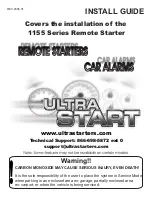
OPERATION - HOW TO CHARGE
ATTENTION
Suitable for all type of 12V/24V Lead Acid-, Gel-, AGM- and Deep Cycle batteries
1. Turn the control dial to “OFF”
2. Preparing the battery
Firstly remove the caps from each cell and check that the level of the liquid is sufficient in each cell. If it is below the recommended
level, top up with de-ionized or distilled water.
NOTE: Under no circumstances should tap water be used.The cell caps should not be replaced until charging is complete. This allows
any gases formed during charging to escape. It is inevitable that some minor escape of acid will occur during charging.
For permanently sealed battery, it is not necessary to carry out the following checks. Don´t try to open a sealed or maintenance-free bat-
tery.
3. Connection
Please make sure that the charger is not connected to AC power.
First connect the positive charging lead (red) to the positive terminal post of the battery (marked P or +). After that connect the negative
charging lead (black) to the negative terminal post of the battery (marked N or -) or the vehicle frame. It is important to ensure that both
DC clamps are making a good contact with their respective terminal posts.
At last connect the charger’s AC power cable to the mains with an adequate ground.
4. Charging
Turn the control dial to the appropriate charging setting and take note of the LED indicators and display codes.
CHARGE RECOMMENDATION:
Control Dial Setting Recommended application
12V 10A
12V batteries , 50-300AH
12V 30A 12V batteries , 150-600AH
24V 8A 24V batteries , 50-200AH
24V 15A
24V batteries , 60-300AH
The current indicator will display the charge supplied to the battery in Amps.
The charger is charging with up to 9 steps depending on the status of the battery and the LED “charging” is turned on while charging.
When the LED “full” illuminates, the battery is completely charged. Disconnect the charger from the mains. Disconnect the black and
red clips from the terminals of the battery. Inspect the liquid levels in each cell and top up if necessary, using the correct fluid. Any sur-
plus fluid around the cell tops should be wiped off (this should be done with extreme care as it may be acidic/corrosive). Replace the
caps.
www.durite.co.uk
0-648-35-LEAF


























